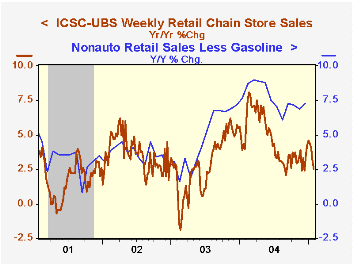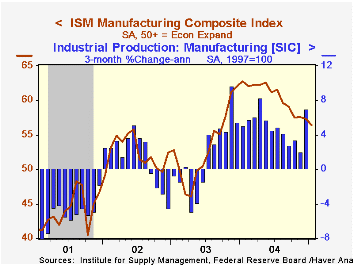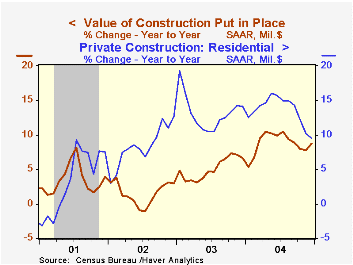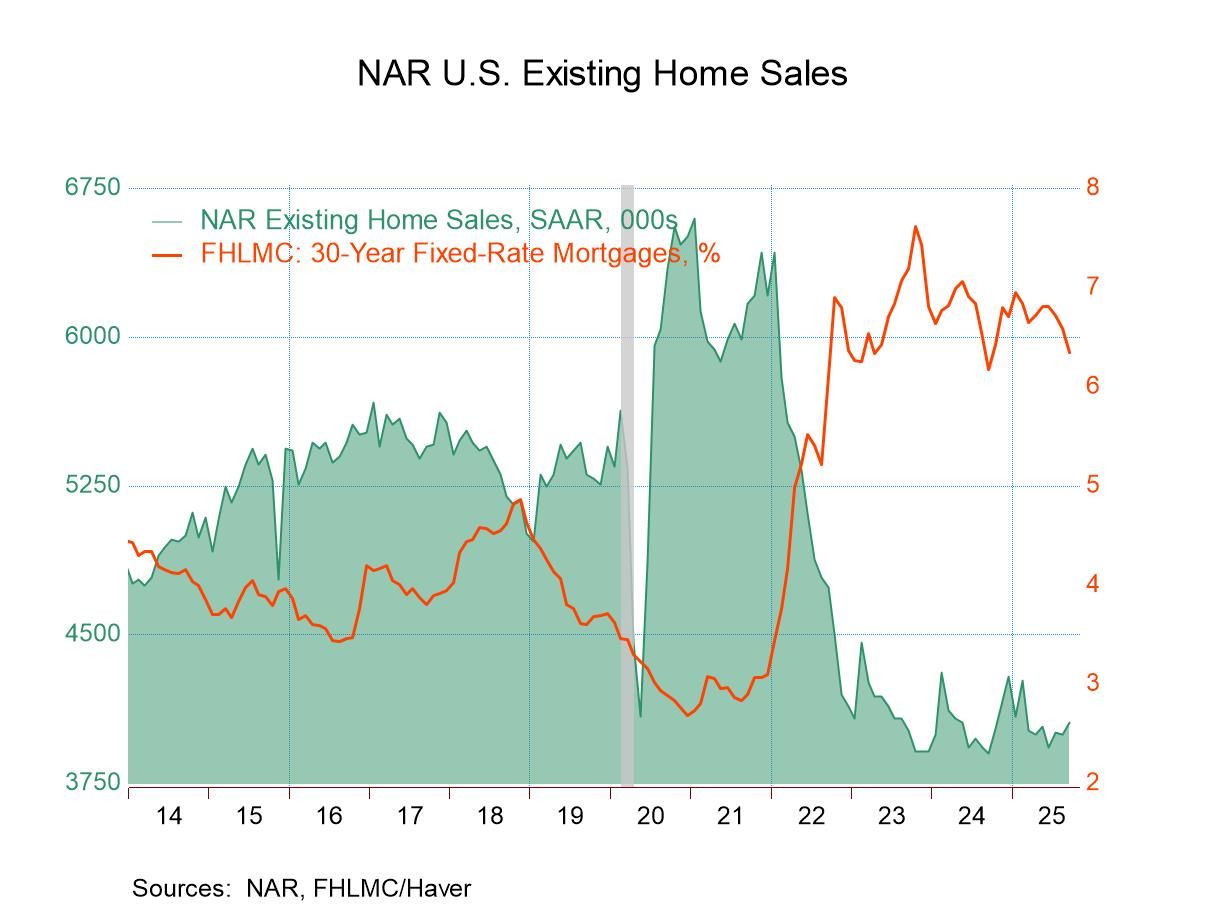 Global| Feb 01 2005
Global| Feb 01 2005Chain Store Sales Fell Hard
by:Tom Moeller
|in:Economy in Brief
Summary
Chain store sales fell 1.9% last week, the third decline this year according to the International Council of Shopping Centers (ICSC)-UBS survey. The decline lowered the average of sales in January to just 0.9% ahead of December. [...]

Chain store sales fell 1.9% last week, the third decline this year according to the International Council of Shopping Centers (ICSC)-UBS survey.
The decline lowered the average of sales in January to just 0.9% ahead of December.
During the last ten years there has been a 58% correlation between y/y change in chain store sales and the change in non-auto retail sales less gasoline, as published by the US Census Department.
The leading indicator of chain store sales from ICSC added 0.5% to the prior week's 1.1% (-0.7% y/y) jump.
The ICSC-UBS retail chain-store sales index is constructed using the same-store sales (stores open for one year) reported by 78 stores of seven retailers: Dayton Hudson, Federated, Kmart, May, J.C. Penney, Sears and Wal-Mart.
| ICSC-UBS (SA, 1977=100) | 01/29/05 | 01/22/05 | Y/Y | 2004 | 2003 | 2002 |
|---|---|---|---|---|---|---|
| Total Weekly Chain Store Sales | 436.0 | 444.3 | 2.5% | 4.6% | 2.9% | 3.6% |
by Tom Moeller February 1, 2005

The Institute of Supply Management reported that its Composite Index of activity in the manufacturing sector slipped last month to 56.4, the lowest level since September 2003. Consensus expectations had been for 56.9 and new seasonal adjustment factors led to revisions of prior months' levels.
During the last twenty years there has been a 69% correlation between the level of the Composite Index and the three month growth in factory sector industrial production.
The new orders component reversed all of the gains in the prior two months and fell 6.1 points to 56.5, the lowest level since June 2003. Conversely, the separate index of export orders ticked up 0.3 points to a near record high. A 2.4 point decline in the supplier delivery index additionally contributed to the composite index's drop.
Other composite index components rose with a 4.8 rise in the employment index recovering nearly all of recent months' declines. During the last twenty years there has been a 69% correlation between the level of the ISM Employment Index and the three month growth in factory sector employment. Production recovered some of the prior three months' decline and inventories were unchanged.
The prices paid index fell for the third straight month, down nineteen points from the high last April.
| ISM Manufacturing Survey | Jan | Dec | Jan '04 | 2004 | 2003 | 2002 |
|---|---|---|---|---|---|---|
| Composite Index | 56.4 | 57.3 | 62.8 | 60.5 | 53.3 | 52.4 |
| New Orders Index | 56.5 | 62.6 | 69.2 | 63.5 | 57.9 | 56.5 |
| Prices Paid Index (NSA) | 69.0 | 72.0 | 75.5 | 79.8 | 59.6 | 57.6 |
by Tom Moeller February 1, 2005

The total value of construction put in place surged 1.1% in December following declines in prior months that were lessened. Consensus expectations had been for a 0.6% gain.The yearend jump lifted the y/y gain in spending to 8.8%, its strongest since 1996.
Private residential building activity recovered 0.7% following two months of decline to finish the year up 13.5%, the biggest gain in ten years. New single family building only rose 0.3% in December but the year's gain of 18.9% was the series' largest.
Nonresidential building jumped 1.2% and rose to the highest level since early 2002 led by a 1.3% gain in office building (+2.9% y/y) and another pop (+2.3%) in multi-retail (27.2% y/y).
Public construction jumped 1.8% and the prior month's gain was revised up sharply. Spending on highways & streets, nearly one third of the value of public construction spending, surged 3.2% (9.1% y/y) for the third consecutive month of strength.Educational spending also was strong for the second month, up 1.7% (8.5% y/y).
These more detailed categories represent the Census Bureau’s reclassification of construction activity into end-use groups. Finer detail is available for many of the categories; for instance, commercial construction is shown for Automotive sales and parking facilities, drugstores, building supply stores, and both commercial warehouses and mini-storage facilities. Note that start dates vary for some seasonally adjusted line items in 2000 and 2002 and that constant-dollar data are no longer computed.
| Construction Put-in-place | Dec | Nov | Y/Y | 2004 | 2003 | 2002 |
|---|---|---|---|---|---|---|
| Total | 1.1% | 0.3% | 8.7% | 8.8% | 5.1% | 1.5% |
| Private | 0.9% | -0.2% | 8.5% | 10.4% | 6.0% | -0.2% |
| Residential | 0.7% | -0.1% | 9.5% | 13.5% | 13.1% | 8.4% |
| Nonresidential | 1.2% | -0.7% | 6.3% | 3.7% | -7.1% | -12.8% |
| Public | 1.8% | 2.3% | 9.4% | 3.6% | 2.6% | 7.0% |
Tom Moeller
AuthorMore in Author Profile »Prior to joining Haver Analytics in 2000, Mr. Moeller worked as the Economist at Chancellor Capital Management from 1985 to 1999. There, he developed comprehensive economic forecasts and interpreted economic data for equity and fixed income portfolio managers. Also at Chancellor, Mr. Moeller worked as an equity analyst and was responsible for researching and rating companies in the economically sensitive automobile and housing industries for investment in Chancellor’s equity portfolio. Prior to joining Chancellor, Mr. Moeller was an Economist at Citibank from 1979 to 1984. He also analyzed pricing behavior in the metals industry for the Council on Wage and Price Stability in Washington, D.C. In 1999, Mr. Moeller received the award for most accurate forecast from the Forecasters' Club of New York. From 1990 to 1992 he was President of the New York Association for Business Economists. Mr. Moeller earned an M.B.A. in Finance from Fordham University, where he graduated in 1987. He holds a Bachelor of Arts in Economics from George Washington University.






